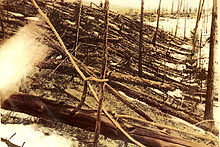Trees felled by the 1908 Tunguska event The Tunguska event —an enormous explosion in a remote region of Siberia on 30 June 1908—has appeared in many works of fiction.
History
The event had a long-lasting influence on disaster stories featuring comets .[ 1]
Cause
While the event is generally held to have been caused by a meteor air burst , several alternative explanations have been proposed both in scientific circles and in fiction.[ 2] [ 3] [ 4] alien spaceship , possibly first put forth in Ed Earl Repp 's 1930 short story "The Second Missile ".[ 3] [ 5] Russian science fiction writer Alexander Kazantsev 's 1946 short story "Explosion ";[ 3] [ 4] [ 6] nuclear bombing of Hiroshima , Kazantsev's story posits that a nuclear explosion in the engine of a spacecraft was responsible.[ 4] [ 7] [ 8] Polish science fiction writer Stanisław Lem 's 1951 novel The Astronauts The Silent Star [ 4] [ 6] [ 9] Ian Watson 's 1983 novel Chekhov's Journey [ 2] [ 3] [ 4] Rudy Rucker and Bruce Sterling 's 1985 short story "Storming the Cosmos " and Algis Budrys 's 1993 novel Hard Landing [ 3] micro black hole , as in Larry Niven 's 1975 short story "The Borderland of Sol " and Bill DeSmedt 's 2004 novel Singularity [ 4] [ 10]
Effect
In Donald R. Bensen 's 1978 novel And Having Writ... the course of history is altered by the arrival of aliens to Earth in 1908, which also causes the Tunguska event.[ 3] [ 11] The X-Files Tunguska " revolves around the impact possibly having introduced alien microbial life to Earth.[ 4] Vladimir Sorokin 's 2002 novel Ice Jacek Dukaj 's 2007 novel likewise titled Ice [ 12]
See also
References
^ Caryad; Römer, Thomas; Zingsem, Vera (2014). "Moderne Mythen zu Kometen" [Modern Myths about Comets]. Wanderer am Himmel: Die Welt der Planeten in Astronomie und Mythologie [Wanderers in the Sky: The World of the Planets in Astronomy and Mythology ] (in German). Springer-Verlag. p. 308. ISBN 978-3-642-55343-1 ^ a b Pringle, David , ed. (1996). "Cosmic collisions" . The Ultimate Encyclopedia of Science Fiction: The Definitive Illustrated Guide . Carlton. pp. 39– 40. ISBN 1-85868-188-X OCLC 38373691 .^ a b c d e f Stableford, Brian (2006). "Meteorite" . Science Fact and Science Fiction: An Encyclopedia 301– 303. ISBN 978-0-415-97460-8 ^ a b c d e f g May, Andrew (2017). "Tunguska" . Pseudoscience and Science Fiction . Science and Fiction. Cham: Springer International Publishing. pp. 32– 35. doi :10.1007/978-3-319-42605-1_2 . ISBN 978-3-319-42604-4 ^ Bleiler, Everett Franklin ; Bleiler, Richard (1998). "Repp, Ed[ward] Earl (1900 or 1901–1979)" . Science-fiction: The Gernsback Years : a Complete Coverage of the Genre Magazines ... from 1926 Through 1936 ISBN 978-0-87338-604-3 ^ a b Determann, Jörg Matthias (2020). "Missions and Mars" . Islam, Science Fiction and Extraterrestrial Life: The Culture of Astrobiology in the Muslim World . Bloomsbury Publishing. pp. 68– 69. ISBN 978-0-7556-0129-5 ^ Britt, Robert Roy (2004-08-12). "Russian Alien Spaceship Claims Raise Eyebrows, Skepticism" . Space.com Archived from the original on 2023-12-05. Retrieved 2024-04-04 . ^ Randles, Jenny (1995). "1908: The Siberian Spacefall". UFO Retrievals: The Recovery of Alien Spacecraft . London: Blandford. p. 21. ISBN 978-0-7137-2493-6 Post-World War 2, aerial photos of the destruction of Hiroshima and Nagasaki were compared with photos of the flattened Siberian taiga. They were stunningly similar. It took less than six months for someone to draw the obvious conclusion. A. Kasantsev, a science-fiction author, published a short story in January 1946 in which he offered serious speculation that an alien spacecraft powered by nuclear motors had blown up above Tunguska. ^ Westfahl, Gary ; Stevens, Geoffrey (2023). "Schweigende Stern, Der" . In Clute, John ; Langford, David ; Sleight, Graham (eds.). The Encyclopedia of Science Fiction . Retrieved 2024-04-04 .^ Clute, John (2022). "DeSmedt, Bill" . In Clute, John ; Langford, David ; Sleight, Graham (eds.). The Encyclopedia of Science Fiction . Retrieved 2024-04-05 .^ Clute, John (2022). "Bensen, D R" . In Clute, John ; Langford, David ; Sleight, Graham (eds.). The Encyclopedia of Science Fiction . Retrieved 2024-04-05 .^ Petzer, Tatjana (September 2013). "Re-Writing the Tunguska Event: The icy imagination of Vladimir Sorokin and Jacek Dukaj" . Archives of the Arctic. Ice, Entropy and Memory .
